News
Labor Day: A Historical Overview of the American Holiday

Labor Day, celebrated on the first Monday of September, marks a significant history in the United States. Its origins trace back to the late 19th century, when activists sought to dedicate a day to honor the contributions of workers.
The inaugural Labor Day celebration occurred in New York City on September 5, 1882. Organized by the Central Labor Union and the Knights of Labor, approximately 10,000 workers participated in a parade to advocate for better working conditions.
Over the years, various cities and states recognized Labor Day, prompting President Grover Cleveland to sign a congressional act in 1894, officially establishing it as a federal holiday. This move came shortly after the violent Pullman Strike, where federal troops intervened, resulting in numerous casualties.
Barbecuing has become a cherished tradition of Labor Day. Historical accounts suggest that gatherings centered on communal dining were prevalent even in the initial celebrations.
Today, many Americans view Labor Day as a time for leisure and family gatherings, though some remain aware of its labor origins, particularly in regions with prominent union activity. In Chicago, for example, a parade and festival commemorate the holiday’s roots in the Pullman neighborhood.
While Labor Day serves as a federal holiday, its recognition varies across states and private sectors, as not all employers provide time off for their employees. The National Labor Relations Act of 1935 played a pivotal role in granting rights to join unions for private sector employees, a crucial development in labor rights.
In current times, discussions surrounding workers’ rights are resurfacing, with new generations becoming increasingly active in labor movements. This resurgence emphasizes ongoing struggles related to working conditions and compensation in today’s economy.












